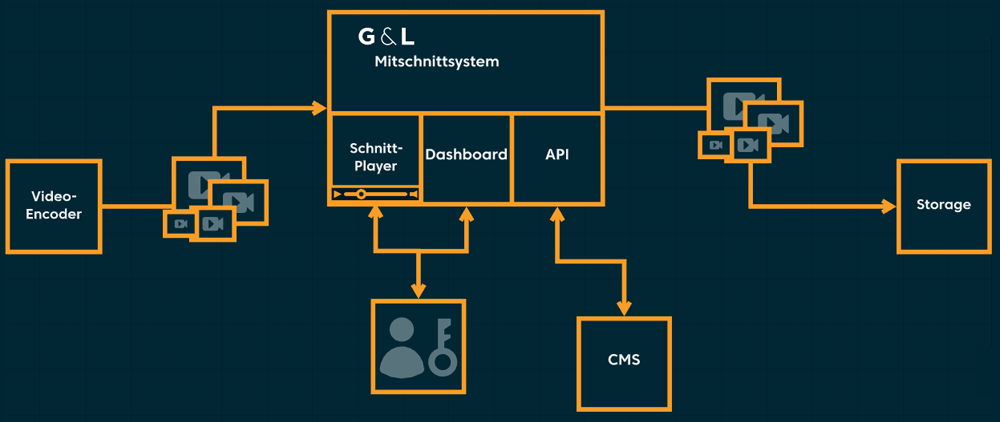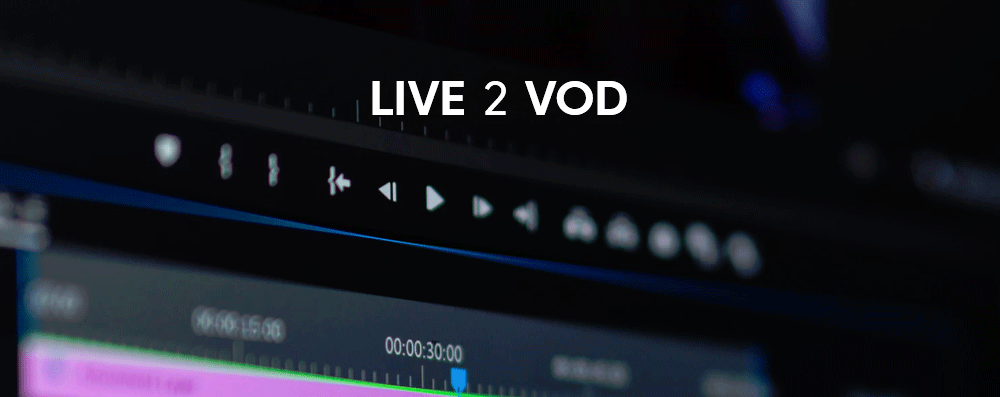The G&L recording system: Providing live streams as video-on-demand – fast, error-free and cost-effective. From broadcasters to online editorial offices to event streamers, more and more companies are struggling with this challenge. How our all-round solution provides a remedy.
Monday evening, 9 p.m. in an online editorial office: A programme is coming to an end, which the viewers are just watching in the livestream. Ten minutes later, the programme is supposed to be available in the media library as video-on-demand. But this narrow time window is no reason for the assistant editor to get stressed out. Instead, the employee comfortably pours himself a coffee, sits down in front of the PC and opens a browser. This gives him access to our recording system. The highlight: the software, which is now used by broadcasters nationwide, cuts the livestream semi-automatically and turns it into an mp4 video. Minutes after the end of the broadcast, the programme appears in the media library – faster, less stressful and more error-free than would be possible by hand.Video on Demand: internet users' demands are rising – companies are under pressure
In the past, if people wanted to watch the daily news, they had to sit in front of the television at 8 p.m. sharp. Linear slapdash cinema followed a schedule. But for a long time now, the internet has been changing media use. It is more popular than ever to watch videos on the net, regardless of the time of day. Eight out of ten internet users stream online videos at least occasionally, a study by the digital association Bitkom shows. "Video streaming is one success story and has permanently changed people's viewing behaviour," Bitkom expert Sebastian Klöß is convinced. And users' demands are rising – they expect online videos in the media library after the end of a live broadcast. Quality and streaming without delay are taken for granted. No wonder companies are coming under pressure.
Recording system as all-round solution replaces heterogeneous system landscape
A common problem is that those responsible use a heterogeneous system landscape to create on-demand videos from live streams. This includes software for signal conversion, editing and data transfer. Time is lost as a result. This is where our solution comes in. The recording system replaces isolated applications with an all-round solution. It simplifies and accelerates work processes. And can also help to save costs.
Users use the Linux software on-premises, in a private or public cloud or in hybrid environments. The operation is identical in all cases – the user identifies themself via their browser and gets access to our recording system, which consists of three main components: a dashboard shows the status of all components and processes. An editing player enables the cutting of live streams. And a programming interface ensures communication with a content management system. HLS live streams, i.e. H.264 MPEG-2 TS videos and M3U8 descriptor files provided by encoders, serve as input for the software.

Architecture sketch
Instead of manual work, software automatically cuts live streams
Our recording system enables the cutting of the live stream into on-demand videos – a step that can be done manually or automatically. With manual editing, the user operates the editing player via their browser. With automatic cutting, on the other hand, the software orients itself to time signals that follow the VPS standard. In this way, long live streams can be automatically converted into several videos. When cutting on reference images (keyframes), no new transcoding is necessary – the software reassembles media segments of the live stream. The system also masters frame-accurate editing. In this case, the software only re-encodes the affected segments. Other functions include multiple editing (cut lists), handling of blackouts via Konkserver, pre- and post-trailers as well as the integration of metadata.
Automatic delivery as video on demand in a few seconds
With the help of our editing system, it is possible to convert live streams into mp4 files in record time and make them available in the media library. For example, the creation of a one-hour video at 4Mbit/s usually takes less than 45 seconds. The on-demand videos can be transferred to the content management system via an API. In addition, a managed file transfer service for FTP, SFTP and HTTP(S) is integrated into the editing system. To guarantee a smooth workflow and reliable data transfer, we offer 24x7 support with fast response times that reduce downtime to a minimum. In addition, our experts are on hand to provide advice and assistance in customising the recording system.
The most important features at a glance:
- Recording of HLS live streams
- Support for single bit rate (SBR) and adaptive bit rate (ABR)
- Generation of MP4 files and still images
- Automatic and manual frame-accurate editing
- Web interface and REST API
- Monitored upload to target systems
Main advantages:
- Automation of complex Live2VOD workflows possible
- Extremely fast delivery of ready-made recordings, even with ABR
- Target-oriented web interface enables easy operation
- Pure software solution based on Linux & Docker
- Operation on-premises, in private or public cloud as well as in hybrid environments
- Optional CMS integration via API

